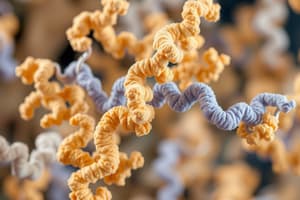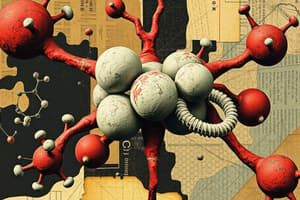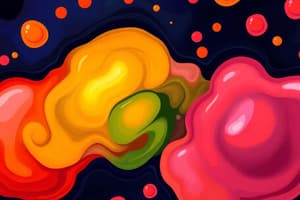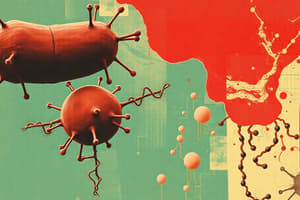Podcast
Questions and Answers
What is the primary role of hemoglobin in the body?
What is the primary role of hemoglobin in the body?
- To transport nutrients to cells
- To regulate body temperature
- To maintain blood pH levels
- To transport gases through the blood (correct)
Which statement describes the T state of hemoglobin?
Which statement describes the T state of hemoglobin?
- It is the tense state without oxygen binding. (correct)
- It is characterized by high affinity for carbon dioxide.
- It represents a stable configuration when all sites are occupied.
- It is the relaxed state where oxygen is tightly bound.
What effect do protons and CO2 have on hemoglobin's affinity for oxygen?
What effect do protons and CO2 have on hemoglobin's affinity for oxygen?
- They do not affect hemoglobin's function.
- They cause hemoglobin to become fibrous.
- They decrease hemoglobin's affinity for oxygen. (correct)
- They increase hemoglobin's affinity for oxygen.
Which characteristic of hemoglobin allows it to exhibit cooperative binding?
Which characteristic of hemoglobin allows it to exhibit cooperative binding?
What is the composition of hemoglobin in terms of its polypeptide chains?
What is the composition of hemoglobin in terms of its polypeptide chains?
What is the primary function of hemoglobin in erythrocytes?
What is the primary function of hemoglobin in erythrocytes?
Which structural feature distinguishes myoglobin from hemoglobin?
Which structural feature distinguishes myoglobin from hemoglobin?
What role does the iron atom in the heme group play in oxygen binding?
What role does the iron atom in the heme group play in oxygen binding?
Which amino acid is critical for coordinating with iron in the heme group of myoglobin?
Which amino acid is critical for coordinating with iron in the heme group of myoglobin?
How does carbon monoxide affect hemoglobin's function?
How does carbon monoxide affect hemoglobin's function?
What is a characteristic feature of fibrous proteins like collagen?
What is a characteristic feature of fibrous proteins like collagen?
Which type of collagen is most abundant in the human body?
Which type of collagen is most abundant in the human body?
Which factor primarily affects oxygen binding to myoglobin and hemoglobin?
Which factor primarily affects oxygen binding to myoglobin and hemoglobin?
What is the primary physiological adaptation of 2,3-bisphosphoglycerate (BPG) in high altitudes?
What is the primary physiological adaptation of 2,3-bisphosphoglycerate (BPG) in high altitudes?
What characteristic is primarily associated with fibrous proteins?
What characteristic is primarily associated with fibrous proteins?
What is the repeating amino acid sequence found in collagen?
What is the repeating amino acid sequence found in collagen?
How do cross-links in collagen fibers affect their properties?
How do cross-links in collagen fibers affect their properties?
Which type of collagen provides resistance to tension and is commonly found in tendons and skin?
Which type of collagen provides resistance to tension and is commonly found in tendons and skin?
What structural feature characterizes the collagen helix?
What structural feature characterizes the collagen helix?
What effect does CO2 binding have on hemoglobin?
What effect does CO2 binding have on hemoglobin?
Which amino acid is most commonly found in the Gly–X–Y sequence of collagen?
Which amino acid is most commonly found in the Gly–X–Y sequence of collagen?
Flashcards
Hemoglobin's Structure
Hemoglobin's Structure
Hemoglobin is a quaternary protein with four polypeptide chains (2 alpha and 2 beta subunits) and four heme groups.
Hemoglobin Function
Hemoglobin Function
Hemoglobin transports oxygen through the bloodstream.
Allosteric Protein
Allosteric Protein
A protein with multiple binding sites, where binding at one site affects binding at another.
Oxygen Binding to Hemoglobin
Oxygen Binding to Hemoglobin
Oxygen binding is cooperative and allosteric; initial binding facilitates subsequent binding to adjacent subunits.
Signup and view all the flashcards
Factors Affecting Oxygen Binding
Factors Affecting Oxygen Binding
High CO2 and proton (H+) concentrations decrease hemoglobin's affinity for oxygen, releasing it to tissues.
Signup and view all the flashcards
Globular protein
Globular protein
A type of protein with a compact, roughly spherical shape, that is often soluble in water. They perform diverse biological functions such as acting as enzymes or transport proteins.
Signup and view all the flashcards
Myoglobin
Myoglobin
A globular protein that stores oxygen in muscle tissue.
Signup and view all the flashcards
Hemoglobin
Hemoglobin
A globular protein in red blood cells that transports oxygen from the lungs to the tissues and carbon dioxide from the tissues to the lungs.
Signup and view all the flashcards
Heme group
Heme group
A non-protein part of myoglobin and hemoglobin, containing iron, crucial for oxygen binding.
Signup and view all the flashcards
Proximal Histidine
Proximal Histidine
Amino acid residue coordinating with the iron atom in the heme group of both myoglobin and hemoglobin.
Signup and view all the flashcards
Quaternary structure
Quaternary structure
The structure of a protein comprising multiple polypeptide chains.
Signup and view all the flashcards
Tertiary structure
Tertiary structure
The three-dimensional arrangement of a single polypeptide chain.
Signup and view all the flashcards
Apoprotein
Apoprotein
The protein part of a conjugated protein (without its prosthetic group).
Signup and view all the flashcards
CO2 and Hemoglobin Binding
CO2 and Hemoglobin Binding
Carbon dioxide (CO2) binds to hemoglobin, decreasing its affinity for oxygen.
Signup and view all the flashcards
2,3-BPG and High Altitudes
2,3-BPG and High Altitudes
2,3-BPG helps the body adapt to high altitudes by decreasing hemoglobin's oxygen affinity, making oxygen release easier.
Signup and view all the flashcards
Fibrous Protein Insoluble in Water
Fibrous Protein Insoluble in Water
Fibrous proteins have a high concentration of hydrophobic (water-fearing) amino acids, making them insoluble.
Signup and view all the flashcards
Fibrous Protein Structure
Fibrous Protein Structure
Fibrous proteins have structural roles, providing strength and flexibility to tissues and complexes.
Signup and view all the flashcards
Collagen Function
Collagen Function
Collagen is a structural protein, vital for strong connective tissue, including tendons, cartilage, and bone.
Signup and view all the flashcards
Collagen Helix Structure
Collagen Helix Structure
Collagen's secondary structure is a left-handed helix with a specific amino acid sequence (Gly-X-Y), where X and Y are often proline and hydroxyproline.
Signup and view all the flashcards
Collagen Fiber Strength
Collagen Fiber Strength
Collagen fibers' strength comes from the way tropocollagen molecules associate, forming cross-links using covalent bonds.
Signup and view all the flashcards
Collagen Types and Tissues
Collagen Types and Tissues
Different collagen types exist, varying in cross-links and function. Type I collagen, for example, is abundant in skin, bone, tendons and teeth.
Signup and view all the flashcardsStudy Notes
Structure-Function Relationship in Specific Proteins
- Globular proteins, such as hemoglobin and myoglobin, have a compact, roughly spherical shape.
- Globular proteins are water-soluble, readily dissolving in blood.
- Globular proteins have diverse functions, including acting as enzymes, transporting substances, and regulating processes.
- Examples of globular proteins are enzymes, transport proteins, motor proteins, regulatory proteins, and immunoglobulins.
- Globular proteins have a size range from 2000Å x 5Å (B conformation) to 900Å x 11Å (a helix).
Myoglobin and Hemoglobin
- Myoglobin is a heme protein found in muscle tissue.
- Its function is to store oxygen and supply for intense respiration.
- Myoglobin has a tertiary structure.
- Hemoglobin is a heme protein found in red blood cells (erythrocytes).
- Its function is to transport oxygen from the lungs to tissues and carbon dioxide from tissues to the lungs.
- Hemoglobin has a quaternary structure.
- Both myoglobin and hemoglobin have heme prosthetic groups that contain iron in its ferrous (Fe2+) state.
Heme Group Structure
- The heme group's complex organic ring structure is a protoporphyrin.
- Iron at the center of the heme group forms six coordination bonds.
- Four bonds are in the same plane as the porphyrin ring
- Two bonds are perpendicular to the plane of the porphyrin ring.
Globular Proteins - Important Residues
- The heme group is located within a hydrophobic pocket in the apoprotein.
- This protects the iron from oxidation.
- The pocket also prevents carbon monoxide from binding to the heme group.
- In both myoglobin and hemoglobin, specific amino acid residues are crucial for oxygen binding.
Hemoglobin (Continued)
- Hemoglobin is an oligomeric protein with a quaternary structure.
- It consists of four polypeptide chains (2 α subunits and 2 β subunits).
- Each subunit has a bound heme prosthetic group.
- Subunits are arranged in pairs.
- Their arrangement in the protein relies on noncovalent interactions.
Allosteric Interactions (Hemoglobin)
- Hemoglobin is an allosteric protein, meaning interactions at one site influence binding at another.
- Oxygen binding to one subunit facilitates oxygen binding to adjacent subunits.
- Hemoglobin exhibits two main conformational states (T-state and R-state).
- The binding of oxygen causes a conformational shift (T → R).
- The change in shape increases oxygen binding affinity in hemoglobin.
Factors Affecting Oxygen Binding (Hemoglobin)
- The concentration of protons (H+) and carbon dioxide (CO2) in peripheral tissues affects hemoglobin's oxygen affinity.
- High H+ and CO2 levels reduce oxygen affinity.
- This allows oxygen release to the tissues as needed.
- 2,3-bisphosphoglycerate (BPG) is another factor influencing oxygen affinity.
- Higher BPG concentration decreases oxygen affinity in hemoglobin.
Fibrous Proteins (General Description)
- Fibrous proteins are insoluble in water due to their high concentration of hydrophobic amino acids on their surfaces.
- They play important structural functions, often providing strength and flexibility to tissues.
- They form complex supramolecular structures with similar polypeptide chains packed together.
- Common examples include collagen, myosin, and actin.
Collagen
- Collagen is an important structural fibrous protein.
- It provides strength to connective tissues like tendons, cartilage, and bone.
- Collagen has a highly organized, repetitive amino acid sequence (Gly-X-Y).
- Contains large amounts of Glycine, Proline, and Hydroxyproline amino acids.
- These particular amino acids are important components of the left-handed coiled structure in collagen.
- Collagen fibers are also stabilised by cross-links, which are covalent bonds resulting in differing degrees of flexibility or rigidity.
Myosin
- Myosin is a fibrous protein that is a component in muscle cells.
- It contains multiple subunits, including 2 heavy chains and 2 light chains.
- The carboxyl terminus of the polypeptide chains forms a long tail, with the amino terminus forming a head.
- The head forms cross bridges with actin in muscle contraction.
Actin
- Actin is a fibrous protein that also plays a role in muscle contraction.
- It's a component of the thin filaments in muscle.
- Actin is composed of G-actin monomers in a right-handed polymerized structure called F-actin.
- Actin has a high affinity for G-actin monomers with specific binding sites for myosin.
Studying That Suits You
Use AI to generate personalized quizzes and flashcards to suit your learning preferences.




